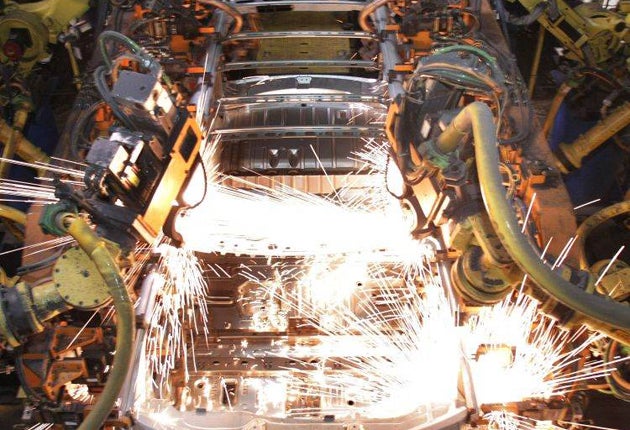How General motors came back from the brink
The largest share offering in US history begins today and marks the rebirth of the car-making giant

General Motors, the giant car maker, races back on to the US stock market this morning, after the biggest share offering in American history, and investors were falling over themselves to get a piece of the company.
Just a day after saying it would raise the price of its shares, GM yesterday decided also to increase the number of shares being sold, resulting in billions of dollars extra for its current owners, the US and Canadian governments and the unions representing thousands of retired workers. It is on course to raise $23.1bn, giving the company a market value around $50bn.
Last night, as it set the price for ordinary shares at $33 apiece, the top of its increased range, analysts were already weighing in on the long-term prospects for the company, which since last year has called itself “New GM”. Its pit stop in bankruptcy allowed it to shed thousands of workers, billions of dollars in pension and healthcare liabilities, underperforming factories, unwanted dealerships and four of its eight brands, including Pontiac, Saturn and the notorious gas-guzzler Hummer.
Some $6bn of the IPO proceeds will go to funding obligations to retired workers, helping to resolve a structural problem that had hobbled GM for a generation: it is supporting five times as many retirees as it has employees.
“The old joke was the GM was the world’s largest [health management organisation], which just happened to also sell cars,” says David Whiston, a car industry analyst at Morningstar. “Healthcare costs in the US had just gotten out of control. The company has $5bn in hourly worker costs annually now, compared to $16bn in 2005... The company has posted well over $4bn in net income so far this year. This is a very, very different company.”
After years where it lost around $1,000 on every car it made in North America, GM now turns a profit of around $3,000, and with car sales in the US recovering from the effects of the recession, analysts are forecasting its margins can expand. As importantly, it has had some sales successes, with popular models such as the Chevrolet Traverse mini-SUV and the Buick Lacrosse, a luxury sedan, and has generated some buzz around its forthcoming Chevy Volt, an electric car.
Mr Whiston said he expected the shares to rise towards a fair value of $44. “Old GM” bonds which are still trading, and which will eventually convert into New GM shares, suggest that the stock could be worth in the high-$30s.
Both the Bush and Obama administrations feared that the collapse of GM and its cross-town rival Chrysler would have effects far beyond the companies themselves, as suppliers folded and hundreds of thousands, or possibly millions, of jobs were put at risk. As a result, Wall Street bailout money was redirected to the car industry, and the process of remaking GM began in December 2008.
The US taxpayer has held a 61 per cent stake in GM as a result of the restructuring. To break even on its investment, the Treasury must get an average price of $44 per share, but it decided that it would rather sell more shares now, at a price which risks an ultimate loss to taxpayers, instead of waiting. Its stake is being cut to about 33 per cent, against the earlier planned 43 per cent. GM has been eager to shake off the moniker “Government Motors”, while the Treasury is keen to extricate itself from major interventions in the private sector.
GM sold 478 million common shares at $33 each, raising $15.77bn, as well as $4.35bn in preferred shares, also more than initially planned. Including an overallotment option, which will be settled over the next few days, GM looks set to raise $23.1bn - the biggest initial public offering ever.
What it means for GM's rivals
The ease with which General Motors has found buyers for its initial public offering bodes well for rival Chrysler's own planned return to the stock market, Sergio Marchionne, Chrysler chief executive says.
Speaking in Los Angeles ahead of the city's auto show, Mr Marchionne said Chrysler would not bring forward its IPO plans, pencilled in for the second half of 2011, but would study how GM shares perform. "It will give us the logistics of what this market is looking for, as far as pricing expectations," he said. "This will give us a great, great precursor for the Chrysler IPO. I'm delighted, it couldn't have gone better."
And the executive launched a full-throated defence of the auto bailouts, saying Chrysler had already added 12,000 jobs since bankruptcy and that had an even bigger effect on the economy. "I don't care what multiplier you use, one-to-four, one-to-seven, including the pizza guy.
"If you go far enough down the chain, I think the multiplier effect is huge. It just reinforces the fact that President Barack Obama did the right thing. He saw it."
Subscribe to Independent Premium to bookmark this article
Want to bookmark your favourite articles and stories to read or reference later? Start your Independent Premium subscription today.

Join our commenting forum
Join thought-provoking conversations, follow other Independent readers and see their replies